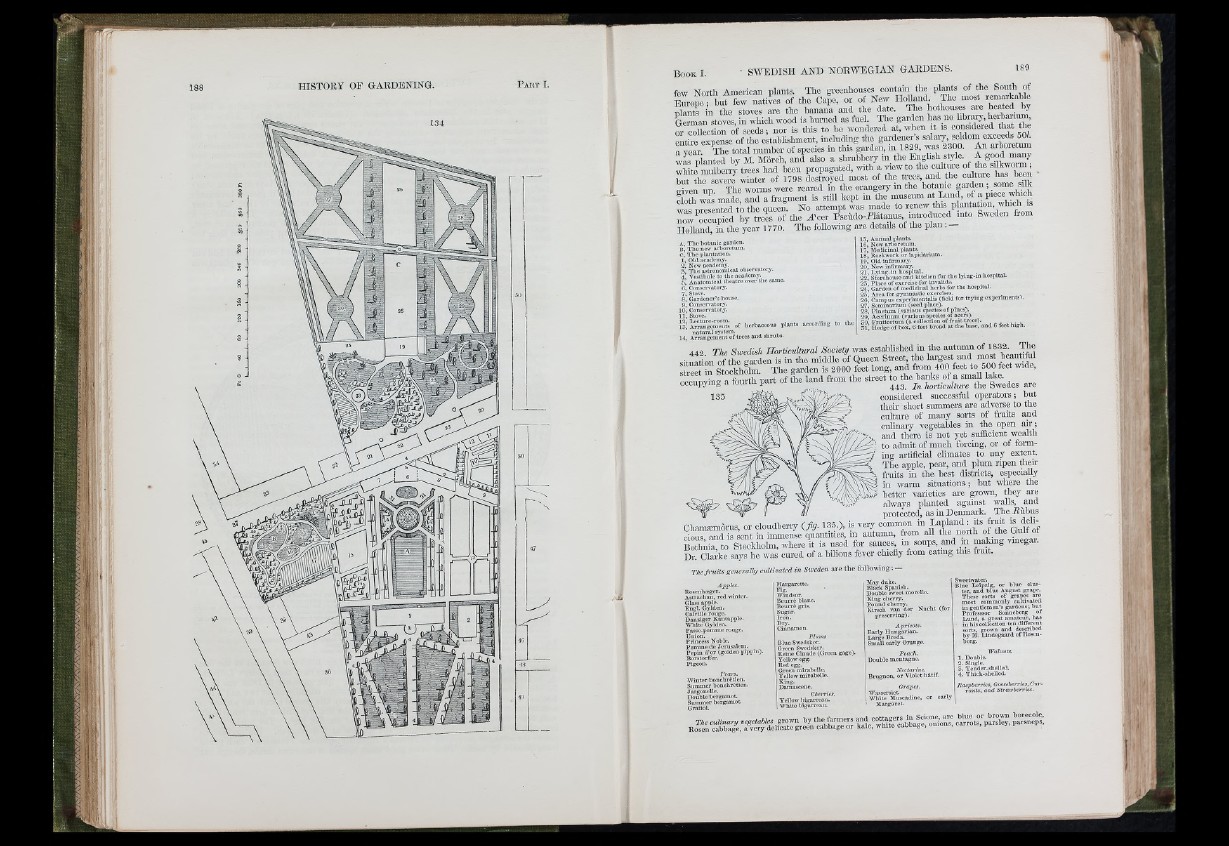
W '
1
r i r
few North American plants. The greenhouses contain the plants of the South ta
Europe • but few natives of the Cape, or of New Ilolland The most remmtable
plants in the stoves are the hanana and the date, nlie hothouses are
stoves, to which wood is burned as fuel. The garden has no hbrary, J L n i m
or collection of seeds i nor is this to he wondered at, when it is considered that tt a
entire expense o fth e establishment, including the = ® “L ’Z L Z r t a l t a ?
a year The total immbcr of species m this gai-den, m 1829, -was 2300. An
w L planted by M. Mbrch, and also a shi-ubbery in the English style. A good many
white mulbonw trees had been propagated, vdtli a view to the culture of the s*wo i-mi ^
hut tho severe winter of 1798 destroyed most of tt a trees, and the culture has bom
I Z n Ip . The lormswei-e reared in tt a orangciy to tt a h o j i e f ™'d® J J L h k h
d o th wls made, and a fragment is still kept in the museum L J ’L A rw h t o h ^ ^
was presented to tt a queen. No attempt was made to renew this p aiitatioii, whicn is
n o Z L Z p i e d by tre ls of tt a A'eer PseMo-Pldtanns inti-oc need into Sweden from
IloUand, in the year 1770. The following arc details of the plan : —
15, Annual plants.
16, New a rboretum.
17, Medicinal plants.
18, Rockwork or lapidarium.
19, Old iufirmary.
20, New infirmary.
i : I h . lta g - 1 «
23, Place of exercise for invalids.
24, Garden o f medicinal herbs for the hospital.
ii’ 1 » « r in g
27? Semmarium (seed place). .
28, Pin etum (various species of pines).
29, Accrinum (various species ot acers). 1?; 6 1 .« hig.„
A, T h e botanic garden.
IS, T h e new a rboretum.
C, The plantation.
1, Old academy.
2, New academy.
5, The astronomical observatory.
4, Vestibule to th e academy.
5? Anatomical th eatre over th e same.
6, Conservatory.
7, Stove.
8, Gardener’s house.
9, Conservatory.
10, Conservatory.
11, Stove.
! i : hcibpooou. p la n t, accor.ling to tl.o
n a tu ra l system.
14, Arrangement of trees an d shrubs
442 The Swedish Horticultural Society was established in the autumn of 1 J 2 The
sitntoton of the garden is in t t a middle of Queen Street, t t a largest and most beautiM
s tred to Stockholm. The garden is 2000 feet long, and fr®“ '“00 f®®‘ ®’
S p y t o g a fourth part of t t a land from the street are
considered successM operators; but
their short summers are adverse to the
oulturo of many sorts of fi-uits and
culinary vegetables in t t a open a i r ;
and there is not yet sufficient wealth
to admit of much forcing, or of forming
artificial climates to any extent.
The apple, pear, and plum ripen their
% fmits in the best districts, especially
\ v-7? in warm situations; but where the
better vai-ictios arc grown, they are
always planted against walls, ^and
U sif II SI protected, as in Dcmnai-k. Th eRu b u s
ChamiBmonis, or clondbeny ( fg . 135.), is very ®°‘L ? L L S e Z O T t w ' l t a Gidf ta
find is sent in immense quantities, m autumn, from all the north ot the ftu ii or
Bothnia, to Stockholm, ivherc it is used for sauces, in soups, and m malang vmegar.
Dr. Clarke says he was cured of a bilious fever chiefly from eating tins fiuit.
The fru its generally cultivated in Sweden ave tlie following :
Apples.
RoscnhcBgor.
Astrachan, red winter.
Glass apple.
Engl. Gyldcn.
Calvillo rouge.
Danviger Kantapplc.
White Gyldeo.
Passc-pomme rouge.
Inion.
Princess Noble.
'omme do Jerusalem.
’cpin d’o r (golden pippin).
Borstorffcr.
Pigeon.
Fears.
W in ter bonciirfitien.
Summer bonchr6tien.
Jargonelle.
Double bergamot.
Summer bergamot.
Gratioh
Margarette.
Windsor.
Beu rré blanc.
Beurré gris.
Sugar.
Iron.
Dry.
Cinnamon.
Fhnns
Blue Swcdsker.
Green Swedsker.
Beine Claude (Green gage).
Yellow egg.
Red egg.
Green mirabelle.
Yellow m irabelle.
King.
Damascene.
Chei-ries.
Yellow bigarreau.
White bigarreau.
May duke.
Black Spanish.
Double sweet morello.
K ing cherry.
P o u n d cherry.
Kirsch van d e r N a c h t (for
preserving).
A pricots.
E a rly H u ngarian.
Large Breda.
Small e arly Orange.
Peach.
Double montagne.
Nectarine.
Bnignon, o r Violet hâtif.
GrapM,
Wassersict.
Wliito Muscadine,
Margaret.
• early
Sweetwater.
Rluo Leipzig, o r b lu e cluste
r. an d blue August grape.
These sorts of grapes are
mo st commonly cultivated
in gentlemen’s ga rd en s; b u t
Profcsssor Sonneberg of
Lu n d , a g rea t amateur, has
in h is collection ten different
sorts, grown a n d described
b y M. Lin d eg aa rd of Rosenborg.
Wabiuts.
1. Double.
2. Single.
3. Tendcr-shellod.
4. Tliick-shellcd.
Rasphei-ries, Gooseberries, Currants,
an d Strawberries.